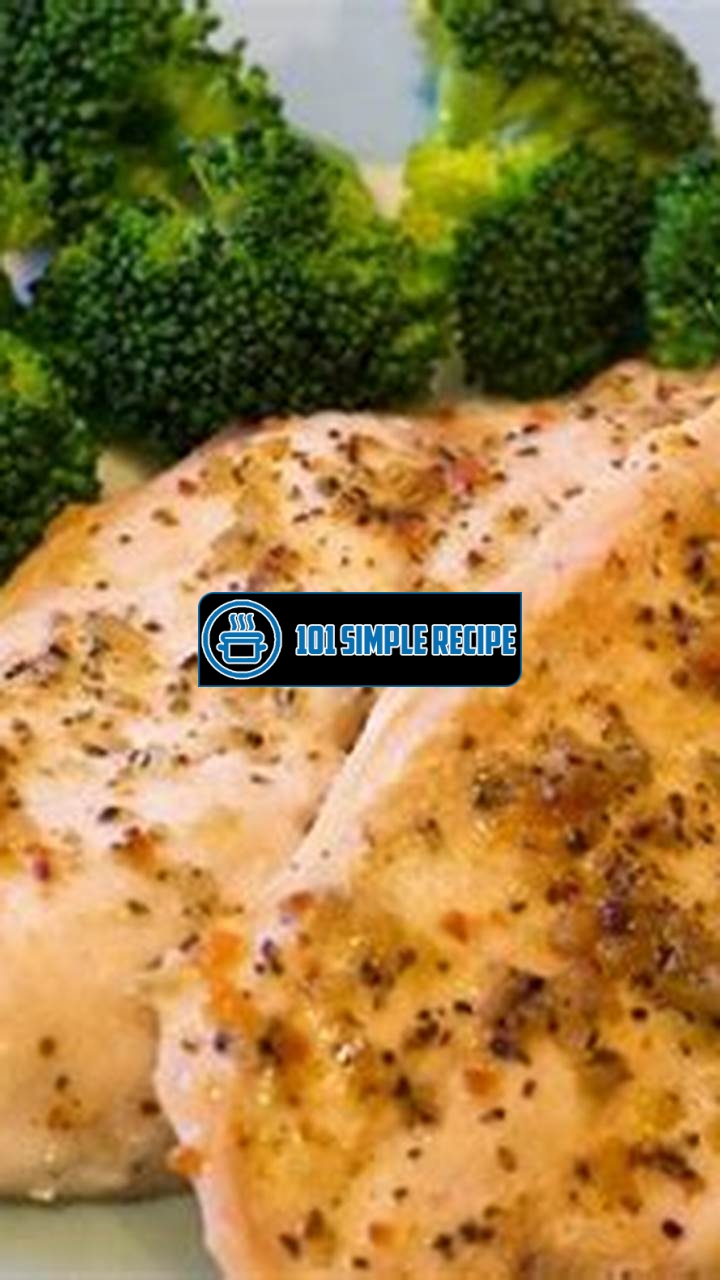Wondering how long it takes to fry a mouthwatering boneless chicken breast? Look no further! In this article, we will dive into the ins and outs of achieving the perfect crisp and juicy chicken breast through frying. Whether you’re preparing a quick weeknight dinner or hosting a backyard barbecue, mastering the art of frying chicken breast is a skill that will never go out of style. With our expert tips and techniques, you’ll have a delicious meal ready to serve in no time! Check out the image below for some culinary inspiration. ️

The Science of Frying Chicken
When it comes to cooking boneless chicken breasts, frying can be a quick and delicious option. The crispy coating and tender meat make for a delightful meal. However, achieving the perfect fried chicken requires an understanding of the science behind it. By uncovering the secrets to frying chicken, you can create a dish that will impress your friends and family every time.
Understanding Frying Temperatures
One of the key factors in frying chicken is the temperature. It is essential to maintain a consistent heat throughout the cooking process. The ideal frying temperature for boneless chicken breasts is between 350°F (175°C) and 375°F (190°C). This temperature range ensures that the chicken cooks evenly and results in a crispy exterior while remaining juicy on the inside.
Note: Keeping the oil at a steady temperature prevents the chicken from absorbing excess oil and becoming greasy. It also helps to achieve the desired golden-brown color.
Choosing the Right Oil
The type of oil you use for frying can significantly impact the taste and texture of the chicken. It is essential to choose an oil with a high smoke point, such as vegetable oil, canola oil, or peanut oil. These oils can withstand the high temperatures required for frying without breaking down or producing a burnt taste.
Note: Avoid using oils with low smoke points, such as olive oil or butter, as they can burn easily and impart an undesirable flavor to the chicken.
Proper Techniques for Dredging and Coating
Another crucial aspect of frying boneless chicken breasts is the process of dredging and coating. This step ensures that the chicken develops a flavorful and crispy outer layer. To achieve this, you can follow these steps:
- Seasoning: Before dredging the chicken, ensure it is properly seasoned with salt, pepper, and any other desired spices.
- Dredging: Dip the seasoned chicken in flour or a mixture of flour and cornstarch. This coating creates a base for the additional breadcrumb or batter layer.
- Coating: For an extra crispy texture, dip the floured chicken in an egg wash or buttermilk bath. Then, coat it with breadcrumbs, panko, or a seasoned flour mixture.
Note: The dredging and coating process helps the chicken retain moisture while providing a crunchy and flavorful crust. Refrigerating the coated chicken for about 30 minutes before frying can also help the coating adhere better during cooking.
In conclusion, understanding the science behind frying chicken is essential for achieving perfectly fried boneless chicken breasts. Maintaining the right frying temperatures, choosing the appropriate oil, and employing proper techniques for dredging and coating can elevate your culinary skills and ensure a delicious meal every time.
Factors Affecting Cooking Time
Discover the variables that influence how long it takes to fry boneless chicken breasts to perfection.
Thickness of the Chicken
The thickness of the chicken breast is a crucial factor that determines the cooking time. Thicker pieces of chicken will require more time to cook compared to thinner ones. When frying boneless chicken breasts, it is essential to ensure that they are evenly thick to promote even cooking. If the chicken breast is not uniform in thickness, certain parts may be overcooked while others remain undercooked.
Keep in mind that the thicker the chicken breast, the longer it will take to fry to reach the desired internal temperature.
Breading or Marinade
The method of breading or using marinades can also impact the cooking time of boneless chicken breasts. When chicken breasts are breaded, such as with breadcrumbs or flour, the coating acts as a barrier between the meat and the heat source. This barrier slows down the transfer of heat, which results in an extended cooking time. On the other hand, marinades can help tenderize the chicken breast but may also add moisture, affecting the frying time.
If you choose to bread your boneless chicken breasts, be aware that it may require a slightly longer cooking time compared to non-breaded ones.
Starting Temperature of the Meat
The temperature at which you begin frying the boneless chicken breasts can influence the overall cooking time. It is recommended to allow the chicken breasts to come to room temperature before frying. Starting with chilled or cold chicken directly from the refrigerator will necessitate a longer cooking time as the chicken needs time to heat through.
Remember to let the chicken breasts come to room temperature before frying them for more consistent and efficient cooking.
In conclusion, several factors affect the cooking time when frying boneless chicken breasts. The thickness of the chicken, the use of breading or marinades, and the starting temperature of the meat all play a role in determining cooking time. By considering these variables, you can achieve perfectly fried boneless chicken breasts every time.
Recommended Cooking Times
When it comes to cooking boneless chicken breasts, there are general guidelines that you can follow to achieve various levels of doneness. The cooking time will depend on the heat level you use and the desired outcome for your chicken. Whether you prefer a golden and juicy texture, a crispy and well-done finish, or a tender and moist bite, adjusting the cooking time and heat is key.
Medium Heat: Golden and Juicy
If you want your boneless chicken breasts to turn out golden and juicy, cooking them over medium heat is the way to go. This cooking method ensures that the chicken is thoroughly cooked while still retaining its moisture. To achieve this, you’ll need to fry the chicken for approximately 6-8 minutes per side. Make sure to flip the chicken halfway through the cooking process to ensure even browning and cooking.
Tip: To check if your chicken breasts are cooked to perfection, you can use a meat thermometer. The internal temperature should reach 165°F (74°C) to ensure that it’s safe to consume.
High Heat: Crispy and Well-Done
If you prefer your boneless chicken breasts to be crispy and well-done, cooking them over high heat will do the trick. This technique allows for a quicker cooking time and results in a deliciously crispy exterior. To achieve this, heat your frying pan over high heat and cook the chicken breasts for approximately 4-5 minutes per side. The higher temperature will sear the outer layer, giving it a desirable crunch.
Tip: To ensure that your chicken is thoroughly cooked, you can cut into one of the breasts to check if the meat is white and no longer pink. Additionally, using a meat thermometer will help you achieve optimal doneness.
Low Heat: Tender and Moist
If you prefer your boneless chicken breasts to be tender and moist, cooking them over low heat is the way to go. This gentle cooking method allows the chicken to cook slowly and retain its natural juices, resulting in a flavorful and moist chicken breast. To achieve this, cook the chicken breasts over low heat for approximately 10-12 minutes per side.
Tip: To add more flavor to your chicken, marinating it before cooking can do wonders. A simple marinade of olive oil, lemon juice, garlic, and herbs can enhance the taste and texture of your chicken.
Remember, these recommended cooking times are just general guidelines. The thickness of your chicken breasts and your desired level of doneness may vary, so keep an eye on the chicken and adjust the cooking time accordingly. With these tips in mind, you’ll be able to fry boneless chicken breasts to perfection, achieving your preferred texture and taste.
Monitoring and Testing for Doneness
When it comes to cooking boneless chicken breasts, it’s essential to monitor and test for doneness to ensure they are cooked to the desired level. There are several foolproof methods you can utilize to achieve perfectly cooked chicken every time. In this article, we will explore three reliable techniques: using a meat thermometer, performing the finger test, and monitoring cooking time.
Using a Meat Thermometer
One of the most accurate ways to determine the doneness of boneless chicken breasts is by using a meat thermometer. This handy tool allows you to monitor the internal temperature of the chicken, ensuring it reaches the safe and recommended temperature of 165°F (74°C) to avoid any risk of foodborne illness.
To use a meat thermometer, start by inserting the probe into the thickest part of the chicken breast without touching the bone. Be sure to take the reading at the center of the breast for the most accurate result. Wait for a few seconds until the temperature stabilizes, and then check the reading displayed on the thermometer.
Note: Remember to clean and sanitize your meat thermometer before and after each use to prevent cross-contamination.
The internal temperature of the chicken should reach 165°F (74°C) at the center. If the reading falls short, continue cooking the chicken until it reaches the recommended temperature. If you notice the chicken is already beyond the desired temperature, unfortunately, it may be overcooked, resulting in a dry and tough texture.
By using a meat thermometer, you can ensure the chicken breasts are cooked to perfection, with a juicy and tender texture that will delight your taste buds!
Performing the Finger Test
An alternate method for testing the doneness of boneless chicken breasts is the finger test. This technique involves relying on your sense of touch to determine the level of doneness. While it may not be as precise as using a meat thermometer, it can still provide reasonably accurate results.
To perform the finger test, gently press the center of the cooked chicken breast using your index finger. The level of firmness will indicate how well the chicken is cooked. Here’s a breakdown of what to feel for:
- Raw: The chicken feels soft and squishy, indicating it is still raw and requires further cooking.
- Undercooked: The chicken feels slightly firm but still quite tender. It needs more time on the heat.
- Perfectly cooked: The chicken is firm yet still moist, bouncing back slightly when pressed. This is the ideal doneness level.
- Overcooked: The chicken feels very firm and dry, lacking moisture. It has been cooked for too long.
Using the finger test requires some practice to develop a sense of touch and familiarity with the desired doneness. However, once perfected, it can be an effective and convenient way to determine if your boneless chicken breasts have been cooked to your liking.
Monitoring Cooking Time
Another approach to ensuring the doneness of boneless chicken breasts is by monitoring the cooking time. This method requires you to have a general idea of the recommended cooking time depending on the size and thickness of the chicken breasts.
As a general guideline, boneless chicken breasts typically take around 6 to 8 minutes per side to cook on a stovetop over medium-high heat. However, factors like the thickness of the chicken and the heat intensity may vary, so it’s essential to continuously monitor the cooking process.
Keep an eye on the chicken as it cooks, observing its color and texture. The chicken should turn golden brown on the outside while remaining juicy and tender on the inside. If you notice any pinkness or rawness in the center, it’s a clear sign that the chicken needs more time.
Remember to adjust the cooking time accordingly if you are using a different cooking method, such as baking or grilling. The key is to ensure the chicken reaches an internal temperature of 165°F (74°C) and is thoroughly cooked before consuming.
By monitoring the cooking time, you can avoid undercooking or overcooking the boneless chicken breasts, resulting in a perfectly cooked and delicious meal.
Troubleshooting Common Issues
When it comes to frying boneless chicken breasts, there are a few common issues that can arise and affect the end result. The good news is that with some troubleshooting and a little know-how, you can overcome these challenges and achieve perfect results every time. In this article, we will discuss the most common issues faced when frying boneless chicken breasts and provide you with tips on how to overcome them.
Burnt or Overly Darkened Exterior
One of the most frustrating issues when frying boneless chicken breasts is ending up with a burnt or overly darkened exterior. This can happen when the heat is too high or when you cook the chicken breasts for too long. To prevent this from happening, follow these steps:
- Make sure to preheat your oil to the correct temperature. Use a thermometer to check the temperature, which should be around 350°F (175°C).
- Coat the chicken breasts with flour, breadcrumbs, or another coating of your choice. This will create a protective barrier and help prevent the exterior from burning.
- Cook the chicken breasts for the recommended amount of time. Generally, boneless chicken breasts should be fried for about 6-8 minutes per side. Keep an eye on them and adjust the cooking time as needed.
- If you notice that the exterior is browning too quickly, lower the heat slightly to prevent burning.
- Remove the chicken breasts from the oil as soon as they reach an internal temperature of 165°F (74°C). Let them rest for a few minutes before serving.
By following these steps, you can avoid ending up with a burnt or overly darkened exterior on your boneless chicken breasts.
Uncooked or Undercooked Interior
Another common issue when frying boneless chicken breasts is ending up with an uncooked or undercooked interior. This can be a result of not cooking the chicken breasts for long enough or not maintaining the correct oil temperature. To ensure that the interior is cooked properly, follow these tips:
- Make sure that your oil is at the correct temperature before adding the chicken breasts. If the oil is not hot enough, the exterior will cook quickly while the interior remains raw.
- Cook the chicken breasts for the recommended amount of time, usually 6-8 minutes per side. Adjust the cooking time as needed, but make sure to cook the chicken thoroughly.
- Check the internal temperature of the chicken breasts using a meat thermometer. The internal temperature should reach 165°F (74°C) to ensure that it is fully cooked.
- Slice into the thickest part of the chicken breast to check for any pinkness or signs of rawness. If you notice any, return the chicken breasts to the oil and continue cooking until they are fully cooked.
By following these tips, you can ensure that the interior of your boneless chicken breasts is cooked properly without any raw or undercooked areas.
Unevenly Cooked Chicken
Uneven cooking is another issue that can arise when frying boneless chicken breasts. This can happen when the heat is not distributed evenly or when the chicken breasts are not of uniform thickness. To achieve evenly cooked chicken breasts, consider the following:
- Pound the chicken breasts to an even thickness before frying. This will help ensure that they cook evenly.
- Use a deep fryer or a large, heavy-bottomed skillet to distribute the heat evenly.
- Flip the chicken breasts halfway through the cooking time to ensure even browning on both sides.
- If your chicken breasts are of different sizes, cook them in batches based on their thickness to achieve uniform cooking.
By following these tips, you can overcome the challenge of unevenly cooked chicken when frying boneless chicken breasts.
In conclusion, when frying boneless chicken breasts, it is important to watch out for common issues such as a burnt exterior, uncooked interior, and uneven cooking. By following the troubleshooting tips provided in this article, you can achieve perfect results every time and enjoy deliciously fried boneless chicken breasts.
Thank you for taking the time to read this article on how long to fry boneless chicken breast. We hope you found the information helpful and informative. If you have any further questions or need additional guidance, please don’t hesitate to reach out. Remember, practice makes perfect when it comes to cooking, so keep experimenting and refining your skills. We look forward to having you visit again soon for more delicious recipes and cooking tips!
Frequently Asked Questions
Here are some frequently asked questions about frying boneless chicken breast:
| No. | Questions | Answers |
|---|---|---|
| 1. | How long should I fry boneless chicken breast? | It is recommended to fry boneless chicken breast for about 4-6 minutes per side or until it reaches an internal temperature of 165°F. Cooking times may vary depending on the thickness of the chicken breast, so it’s always best to use a meat thermometer for accuracy. |
| 2. | What oil should I use for frying chicken breast? | A high smoke point oil like vegetable oil, canola oil, or peanut oil is recommended for frying chicken breast. These oils can withstand the heat without breaking down and imparting a burnt flavor to the chicken. |
| 3. | Should I marinate the chicken before frying? | Marinating the chicken before frying can enhance its flavor and tenderness. You can use your favorite marinade or a simple mixture of olive oil, lemon juice, herbs, and spices. Just make sure to pat the chicken dry before frying to prevent oil splatters. |
| 4. | Can I bread the chicken before frying it? | Breading the chicken before frying can give it a crispy and flavorful coating. You can use a combination of breadcrumbs, flour, or cornmeal along with your favorite seasonings. Dip the chicken in beaten eggs or buttermilk before coating it with the breading mixture. |
| 5. | How can I ensure that the chicken is cooked thoroughly? | To ensure that the chicken is cooked thoroughly, use a meat thermometer to check the internal temperature. It should register 165°F when inserted into the thickest part of the chicken breast. If it’s not fully cooked, continue frying for a few more minutes until it reaches the correct temperature. |
| 6. | What are some serving suggestions for fried boneless chicken breast? | Fried boneless chicken breast can be served as a main dish with mashed potatoes, steamed vegetables, or a fresh salad. It’s also delicious in sandwiches, wraps, or on top of a bed of rice. Feel free to get creative and pair it with your favorite sides and sauces! |
Closing Thoughts
We hope this article has provided you with the necessary information to fry boneless chicken breast to perfection. Remember to adjust the cooking time based on the thickness of the chicken and always use a meat thermometer to ensure it’s cooked thoroughly. Whether you’re making a quick weeknight meal or impressing guests with your culinary skills, fried boneless chicken breast can be a tasty and versatile dish to master. Keep practicing and experimenting with different flavors and techniques, and don’t forget to visit us again for more cooking inspiration. Enjoy your cooking journey and bon appétit!
Jump to Recipe
How Long to Fry Boneless Chicken Breast

Learn how long to fry boneless chicken breast and achieve a delicious and juicy result every time. With the right cooking time and technique, you can enjoy crispy and tender chicken breast that is perfect for any meal.
- 4 boneless chicken breasts
- 1 cup all-purpose flour
- 2 teaspoons salt
- 1 teaspoon black pepper
- 1 teaspoon paprika
- 1/2 teaspoon garlic powder
- 1/2 teaspoon onion powder
- 1/4 teaspoon cayenne pepper
- 2 eggs (beaten)
- 2 cups vegetable oil (for frying)
- Start by pounding the chicken breasts to an even 1/2-inch thickness. This helps them cook more evenly and ensures a tender result. Season both sides of the chicken breasts with salt and black pepper.
- In a shallow dish, combine the all-purpose flour, paprika, garlic powder, onion powder, and cayenne pepper. Mix well to evenly distribute the spices. In another shallow dish, beat the eggs until well combined.
- Dip each seasoned chicken breast into the beaten eggs, then coat it in the flour mixture. Press the chicken firmly into the flour mixture to ensure a good coating. Shake off any excess flour and set the breaded chicken breasts aside.
- In a large skillet or frying pan, heat the vegetable oil over medium-high heat until it reaches 350°F. The oil should be hot enough to fry the chicken without making it greasy.
- Carefully place the breaded chicken breasts into the hot oil, making sure not to overcrowd the pan. Fry them for about 4-6 minutes per side or until they are golden brown and the internal temperature reaches 165°F. Use a meat thermometer to check the temperature.
- Once the chicken breasts are cooked, remove them from the oil and place them on a paper towel-lined plate to drain any excess oil. Allow them to rest for a few minutes before serving. Enjoy your deliciously crispy and juicy fried boneless chicken breasts!






